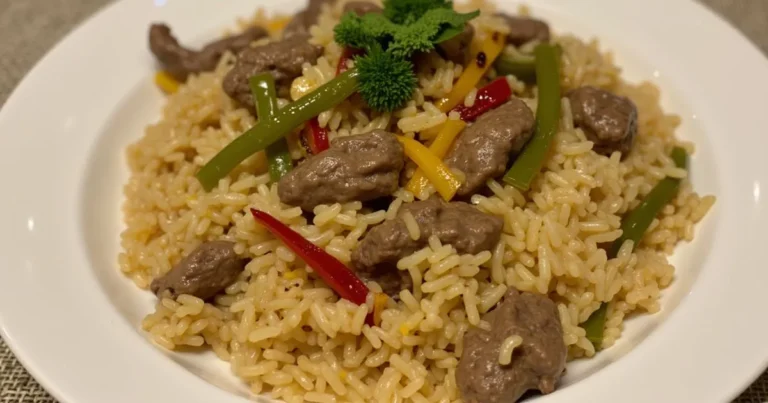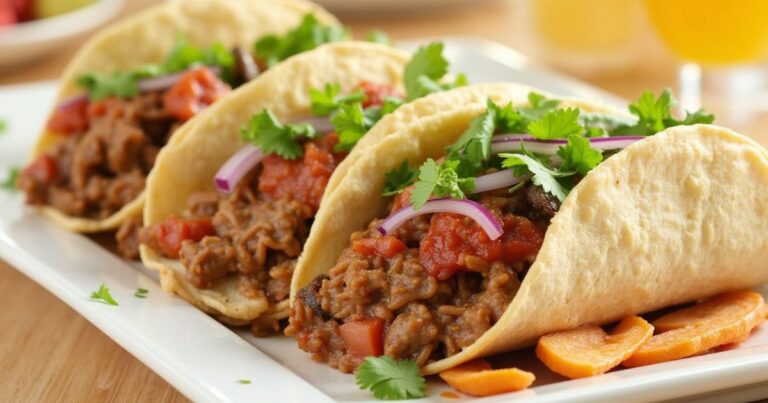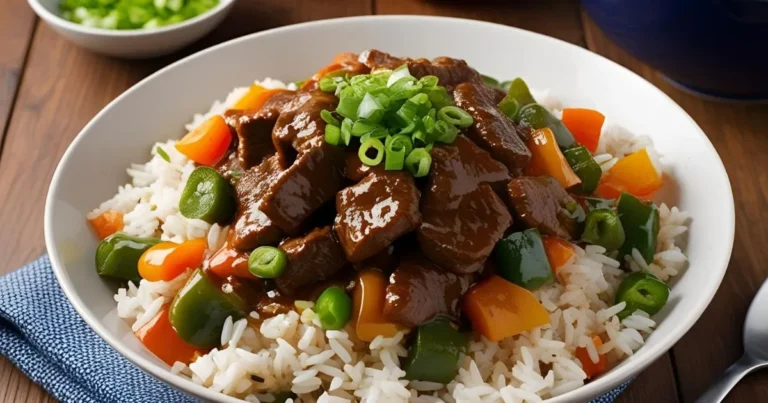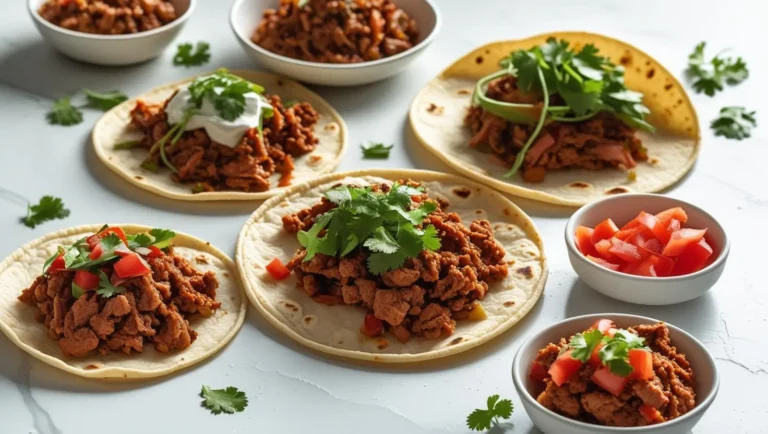Classic Puerto Rican Food Recipes Everyone Should Try
Introduction
OK, so here’s the thing – I was floored when I found out that most Americans have never actually tried real Puerto Rican food. Like, seriously?? You’re missing out on one of the most incredible food experiences of your life!
I still remember my first trip to Puerto Rico back in 2019. I’d gone through a nasty breakup and decided to just book a solo trip somewhere warm. Best decision ever. The beaches were gorgeous, sure, but the FOOD. Oh my god, the food changed my life.
Puerto Rican cuisine isn’t just food – it’s history and family and culture all mixed together on a plate. These Puerto Rican food recipes blend Spanish, African, and indigenous Taíno elements with a dash of American influence. The result? Pure magic that’ll make your taste buds do a happy dance.
I’ve spent the last few years perfecting these recipes, annoying my Puerto Rican friends with a million questions, and becoming obsessed with getting them right. So here are my absolute favorite Puerto Rican food recipes that’ll transport you straight to a beachside kiosk in Luquillo.
Table of Contents
Mofongo: Not Pretty, But OMG So Good
First time I tried mofongo, I stopped mid-bite and had that moment – you know the one – where you realize you’ve been missing out on something incredible your entire life. It’s not the prettiest dish (honestly, it looks like a lump of… something), but that first bite will knock your socks off.
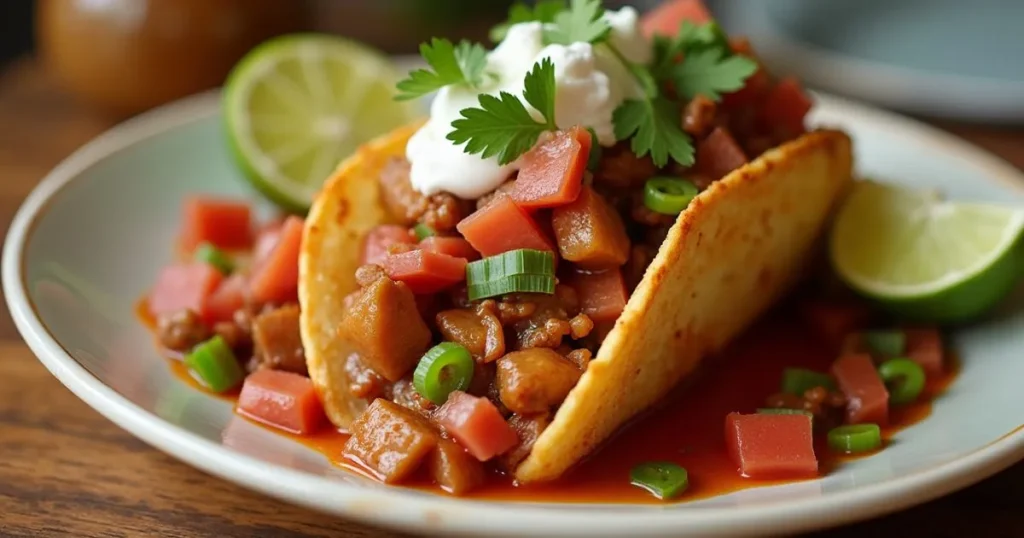
Ingredients List
Grab this stuff:
- 4 GREEN plantains (not yellow, not kinda green – I’m talking GREEN green)
- 2 tablespoons of minced garlic (or like 5 if you’re me and have no fear)
- 6 slices of bacon, fried crispy then crumbled (vegetarians: use 2 tbsp olive oil + smoked paprika)
- 1/4 cup of chicharrones/pork cracklings (the secret weapon!)
- 1/3 cup chicken broth (homemade is best but who has time, right?)
- 2 cups vegetable oil for frying
- 1 teaspoon kosher salt (more to taste – I always end up adding more)
- Handful of chopped cilantro if you’re into that
Quick story – first time I made this, I used ripe plantains because they were the only ones at the store. DISASTER. My Puerto Rican neighbor Miguel, tasted it and just silently handed it back to me with this look of pure disappointment. Lesson learned.
Timing
Prep: About 20 minutes (longer if you’re as clumsy with a knife as I am) Cooking: 25 minutes, give or take Total: 45-ish minutes
I love that this doesn’t take forever. Most Caribbean dishes have me standing over the stove for hours, but this is quick enough for a weeknight when I’m craving something other than another sad bowl of pasta.
Step-by-Step Instructions
Step 1: Battle Those Plantains
OK, so peeling green plantains is a PAIN. They don’t work like bananas! Cut off the ends, score the skin lengthwise, then kind of pry it off with your fingers. It’ll fight you. Persevere.
Chop them into chunks about an inch thick. Toss them in water with a splash of vinegar to prevent browning – learned that one the hard way after serving what looked like dirty potatoes to my friends.
Step 2: Fry Time
Heat your oil till it’s hot but not smoking. Test with a small piece of plantain – it should bubble right away.
Fry those bad boys till they’re golden but not brown, about 4-5 minutes. Don’t crowd the pan! I made this mistake my first three attempts and ended up with soggy, oil-soaked plantains. Not cute.
Do batches if needed – I usually need 2-3 rounds to get through all the plantains. They should be slightly soft when poked with a fork, but not mushy.
Step 3: Flavor Central
While those are frying, grab your mortar and pestle (or food processor if you’re not a purist). Smash that garlic and salt together until it’s a paste.
Add your bacon and chicharrones and keep smashing. Your kitchen will smell INSANE at this point. I’ve had neighbors knock on my door asking what I’m cooking. Not kidding.
Step 4: The Main Event
Drain your plantains on paper towels, then quickly transfer them to your garlic mixture while they’re still hot.
Now channel all your life frustrations into mashing everything together! Add splashes of broth as you go to keep it from drying out.
Pro tip from my friend’s abuela: don’t overmash! You want some texture, not completely smooth like baby food. Think chunky mashed potatoes.
I once made it too smooth, and my Puerto Rican friend’s mom just shook her head sadly at me. Still haunts me.
Step 5: Serve It Up
Pack the mixture into a small bowl you’ve rubbed with oil, then flip it onto a plate for that classic dome shape. Sprinkle with cilantro if you want.
Serve IMMEDIATELY while hot. Seriously, don’t let it sit around – it gets dense and less amazing as it cools.
I like to add a little bowl of extra garlicky broth on the side for dipping. Not traditional, but so good it should be.
Arroz Con Gandules: The Rice Dish That Ruined All Other Rice For Me
Arroz con gandules is Puerto Rico’s national dish, and after one bite, you’ll understand why. This rice and pigeon pea combo is served at every holiday, family gathering, and random Tuesday when you need comfort food.
Ingredients List
- 2 cups medium-grain rice (I use parboiled, but regular works too)
- 1 can (15 oz) gandules/pigeon peas, drained and rinsed
- 3 tablespoons sofrito (homemade is 1000% better – recipe in FAQs)
- 1/4 cup diced ham (skip for vegetarian version)
- 1/4 cup tomato sauce (not paste! I made that mistake once)
- 1 packet sazón with achiote (the ESSENTIAL ingredient)
- 2 tablespoons alcaparrado (olive/caper mix – or just use both separately)
- 3 cups chicken broth (or veggie broth)
- 2 tablespoons olive oil (good olive oil makes a difference here)
- 1 bay leaf
- Salt and pepper to taste
Quick note about sofrito – it’s the soul of Puerto Rican cooking. This herb/veggie paste is in EVERYTHING, and for good reason. I’ve tried store-bought in emergencies, but homemade is where it’s at. My friend’s grandmother actually refused to eat my arroz until I learned to make proper sofrito. Harsh but fair.
Timing
Prep: 15 minutes (5 if you’ve got sofrito ready to go) Cooking: 35 minutes Total: 50 minutes
I make this at least twice a month because it’s quick enough for a weeknight but impressive enough for company. Plus, the leftovers are even better the next day – perfect for lunch when I’m working from home and don’t want to cook.
Step-by-Step Instructions
Step 1: The Flavor Base
Heat that olive oil in a heavy pot (I use my Dutch oven). Add the sofrito and let it sizzle for a couple minutes until it gets fragrant. This smell is so amazing I’ve considered making it into a candle.
Your kitchen will smell like a Puerto Rican grandmother just walked in. It’s that good.
Step 2: Layer In The Good Stuff
Toss in the ham, tomato sauce, sazón, and alcaparrado. Give it a good stir and let it cook for another 2-3 minutes.
This step is where the magic happens – all these flavors melding together. I usually sneak a tiny taste at this point, and it’s all I can do not to just eat this base with a spoon.
Step 3: Rice Is Nice
Add your rice and stir until every grain is coated with that amazing flavor mixture. Pour in your broth, add the bay leaf, and bring to a boil.
Season with salt and pepper, but go easy – there’s already salt in a lot of these ingredients. You can always add more later.
Step 4: The Hardest Part – Do Nothing
Once it’s boiling, add your gandules, give it ONE stir (and only one!), then lower the heat, cover the pot, and WALK AWAY.
This is where I used to mess up constantly. I’m a chronic lid-lifter and stirrer. Don’t be like me. Keep that lid on for 20-25 minutes. No peeking! No stirring! Nothing!
My friend’s abuela taped my pot lid shut once when she was teaching me to make this. Extreme, but effective.
Step 5: The Big Reveal
After 20-25 minutes, take the pot off the heat but leave it covered for another 5 minutes. This part is crucial for getting the texture right.
When you finally lift that lid (what a moment!), you’ll see perfectly cooked rice studded with gandules. Gently fluff with a fork – never a spoon! – and remove the bay leaf.
The best part? If you did it right, you’ll have some pegao – that’s the crispy rice at the bottom of the pot. In my house, we fight over who gets this part.
Nutritional Information
Look, I’m not gonna pretend these are diet foods, but they’ve actually got some solid nutritional benefits:
For Mofongo (per serving, makes about 4):
- Calories: ~325
- Protein: 7g
- Carbs: 48g
- Fiber: 4g (that’s pretty good!)
- Fat: 14g (worth it)
- Sodium: 420mg
- Potassium: 850mg (plantains are potassium superstars)
For Arroz Con Gandules (per serving, makes about 6):
- Calories: ~280
- Protein: 9g
- Carbs: 45g
- Fiber: 5g (thank you, legumes!)
- Fat: 7g
- Sodium: 580mg
- Iron: 2.5mg (14% of what you need daily)
- Vitamin C: 15% daily value
Not too shabby for something that tastes this good, right? Those pigeon peas are little nutritional powerhouses – plant protein, fiber, the works. And plantains give you a solid potassium hit.
Healthier Alternatives for the Recipe
OK, so I’m all about respecting traditional recipes, but I’ve also got friends who are watching their diets or have health restrictions. Here are some tweaks that won’t get you banned from Puerto Rico:
Mofongo Makeover
- Bake the plantains instead of frying: Toss with a little olive oil and bake at 375°F for about 20 minutes. I was skeptical, but it’s pretty good! Cuts the fat by about 65%.
- Use turkey bacon or skip the bacon and add some smoked paprika.
- Try half plantains, half cauliflower – sounds weird but works.
- Low-sodium broth if you’re watching salt
I served the baked version to my friend’s Puerto Rican grandmother, and she gave it a solid “not bad.” Coming from her, that’s a Michelin star.
Arroz Con Gandules Upgrades
- Brown rice is actually amazing in this – takes longer to cook but has a nice nutty flavor
- More gandules, less rice = higher protein meal
- DIY sofrito with no added salt
- Sneak in extra veggies – I add diced bell peppers, carrots, whatever’s in the fridge
- All olive oil instead of any pork fat
I bring the healthier version to potlucks sometimes and people still demolish it. That’s how you know it’s good.
Serving Suggestions
What to serve with these dishes? I’ve got you:
Mofongo Pairings
- The classic: Alongside some garlicky grilled chicken or fish
- The showstopper: Make a well in the center and fill with sautéed shrimp or braised beef (mofongo relleno). This is my “impress the guests” move.
- The party trick: Form into small balls and serve as appetizers with dipping sauce
- The perfect match: A bright, acidic avocado-tomato salad cuts through the richness
Arroz Con Gandules Companions
- The holiday spread: In Puerto Rico, this is Christmas dinner along with pernil (roast pork). Food. Coma.
- The complete meal: Honestly, it’s perfect on its own, but I add quick-pickled red onions on top for a tangy kick
- The meal prep hero: Portion with some roasted chicken and veggies for lunches
- The vegetarian feast: Skip the ham and pair with tostones (twice-fried plantains) and a fresh fruit salsa
Want to know my actual favorite way to eat both these dishes? Standing in front of the fridge at midnight, cold, straight from the container. No shame.
Common Mistakes to Avoid
I’ve made every possible mistake so you don’t have to:
Mofongo Mess-Ups
- Yellow plantains: I did this my first time and ended up with sweet mofongo. Just… no. Green means green!
- Not mashing enough: You need to really work it! But don’t turn it into a paste either.
- Too dry: Keep adding small amounts of broth until it holds together but stays moist.
- Waiting too long to serve: Mofongo stiffens up as it sits. Serve it HOT.
- Bland city: Don’t be shy with the garlic and salt. This isn’t the time for subtlety.
I once made mofongo for a date, and it was so bland he asked if we were eating “plantain mashed potatoes.” We did not have a second date.
Arroz Con Gandules Gotchas
- The peek of doom: DO NOT LIFT THE LID while the rice cooks! Steam escapes, rice gets messed up, grandmothers cry.
- Wrong rice-to-liquid ratio: Medium grain usually needs 1:1.5 rice to liquid.
- Over-stirring: Once everything’s in the pot, that ONE stir is all you get. More makes it gummy.
- Rushing the sofrito: Let it cook down and get fragrant or your whole dish will be missing its foundation.
- Adding gandules too early: They can overcook and turn mushy. Add them just after the rice comes to a boil.
I’ve served undercooked arroz con gandules exactly once at a family gathering. My uncle still brings it up at every holiday. “Remember when you served us crunchy rice?” Yes, Uncle Frank, I remember. Let it go.
Storing Tips for the Recipe
What to do with leftovers (if you somehow have any):
Mofongo Storage
Real talk: mofongo is best fresh. But if you have leftovers:
- Fridge it: Airtight container, 2 days max. Add moisture when reheating or it’ll be like a brick.
- Freezer emergency: Wrap portions in plastic, then foil. Not ideal but works in a pinch.
- Reheating magic: Microwave with a splash of broth and a damp paper towel over top. OR break it up and fry it with eggs for breakfast – game changer!
- The window of deliciousness: After extensive “research” (aka eating mofongo at various stages of leftover-ness), it’s about 80% as good for the first 24 hours, then drops off quickly.
Arroz Con Gandules Afterlife
This stuff was MADE for leftovers:
- Refrigeration: Keeps for up to 5 days in airtight containers. Actually tastes better the next day!
- Freezer friendly: Portion into containers, leave room for expansion, freeze up to 3 months. Future you will send present you a thank you note.
- Sofrito stockpile: Make a huge batch of sofrito and freeze in ice cube trays. Life-changing time saver.
- Reheating right: Add a splash of water when reheating to bring back the moisture.
- Food safety thing: Don’t leave rice at room temp for more than 2 hours – bacteria love that stuff.
Last month I found a container of arroz con gandules in my freezer from who knows when, and it still tasted amazing after reheating. This stuff is magical.
Conclusion
These puerto rican food recipes aren’t just food – they’re little edible time machines that connect you to generations of tradition. Mofongo turns humble plantains into something that’ll make you question why you ever ate regular mashed potatoes, and arroz con gandules proves that rice can be the star of the show.
The best part? They’re super adaptable. Want them spicier? Add more heat. Vegetarian? Skip the meat. Watching carbs? There are workarounds. The soul of these dishes stays intact.
Give these recipes a shot and let me know how they turn out! Drop a comment, share a pic, or just send good vibes. And hey, if you mess them up the first time? Welcome to the club! The best cooks are the ones who’ve screwed up the most recipes. Trust me, I know.
Hit subscribe if you want more recipes that’ll transport you around the world without leaving your kitchen!
FAQs
What makes Puerto Rican cuisine different from other Caribbean food?
Puerto Rican food is like that friend who gets along with everybody but still has a strong personality. While Cuban food leans heavily on Spanish and Jamaican shows stronger African influences, Puerto Rican food recipes dance between all their cultural influences! You’ll find sofrito in everything (seriously, everything), tons of adobo and sazón seasonings, and a deep love affair with plantains and starchy root veggies that sets it apart from other island cuisines.
My first trip to the Caribbean, I island-hopped and could instantly tell when I was eating Puerto Rican food versus other islands’ dishes. The flavor profile is unique!
Can I make sofrito at home instead of buying it?
OMG YES and you MUST! Store-bought is fine in a pinch, but homemade sofrito is a whole different universe. Here’s what I do:
Throw the following in a food processor: 2 green bell peppers, 1 red bell pepper, 2 onions, a whole head of garlic (yes, the whole thing), a bunch of cilantro, half a bunch of culantro if you can find it (check Latin markets), and 2 tbsp oregano.
Blend it up, then freeze in ice cube trays so you always have some ready to go for puerto rican food recipes. It’ll change your cooking game forever. My friend’s abuela finally stopped giving me the side-eye once I started making my own.
Are these dishes gluten-free?
Yep! Both naturally gluten-free, but always check your specific ingredients. Some brands of sazón can have fillers with gluten, and some broths have hidden gluten.
My celiac friend Maria demolished a plate of mofongo at my house and was thrilled to find something traditional that she could eat without modification. Just stick to the traditional recipes – no need for breadcrumbs or flour in authentic versions.
What’s the difference between sofrito and recaito?
This confused the heck out of me for years! People use them interchangeably when talking about Puerto Rican food recipes, but technically:
Sofrito usually has tomatoes (making it reddish), while recaito is green and tomato-free. Both are amazing flavor bases! Recaito tends to be used more for rice dishes and certain soups, while sofrito works across the board in Puerto Rican food recipes.
I keep both in my freezer because I’m extra like that. Different dishes, different sofrito needs!
Can I make these dishes vegetarian/vegan?
Absolutely! For vegetarian mofongo, ditch the bacon and chicharrones and use olive oil with a hit of smoked paprika instead. Use veggie broth too.
Arroz con gandules is super easy to make veggie-friendly – just skip the ham and use vegetable broth. Those pigeon peas already have tons of protein, so you won’t miss the meat.
My sister went vegan last year and was super bummed about missing Puerto Rican food until I made her these veggie versions. She did a happy dance while eating. Success!


